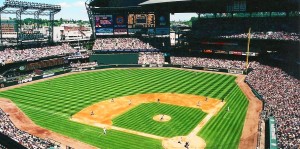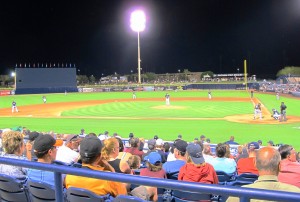Note: With another baseball season upon us, I want to share a few musings, personal observations and realities about what so many find so appealing about this game. Admittedly, much of this article is my subjective opinion, and may be controversial from other points of view; that’s OK with me. Like many others, I love baseball, and this article is a short reflection on why. Take from it what you will…MA

What is it about baseball? What is it that brings us back to this game, season after season; that fills us with nostalgic longing for heroes past and yesteryear’s youth? Why is it that so many of us count among our happiest moments the times we spent as kids, or even as adults, playing or watching this game? (Personally, I never had a year like 1963; my “career year”—the season my little league team won our league championship and I was named our team’s MVP.) Writers devote books, columns of newsprint and digital space to this game; and, pandemics notwithstanding, fans will again flock to ballparks in record numbers, despite overpriced players, tickets, hotdogs and beers. Movies are made about baseball in an effort to capture and illuminate this mystical, hard to define, yet ultimately beguiling quality. Some of them, such as “Field of Dreams”, “The Rookie”, “The Natural” and even in its own way “Bull Durham” (I mean, what true baseball fan would tell you that they don’t belong to the “Church of Baseball”?)[1] do a good job of depicting it, even if they do not come right out and say what “IT” is. With all of these people, writers and artists having so much to say about this basically simple game, you would think that the reason for its allure would be better understood. As another baseball season is looming, and once again many of us will invest hundreds, if not thousands, of dollars and hours over the next 6 months just to watch this game, it seems an appropriate time to share a thought or two about this. Just what is at the root of this fascination with baseball?
A few years back I was down in the Arizona desert with several friends attending the Seattle Mariners spring training. If you are a baseball fan and have never done this, then do yourself a favor and put it on your “bucket list”—and as soon as you can, do it. Spring training is the closest I have ever been to baseball heaven. During spring training in the desert it’s all baseball 90% of the time, the other 10% being spent wetting your whistle at the Salty Senorita, a rowdy watering hole strategically located within eyeshot of the Mariners’ spring training ballpark in Peoria, a suburb of Phoenix.

One crystalline afternoon the Mariners were playing the Colorado Rockies at the Rockies’ Cactus League home ballpark complex, which is known by the interesting name of “Salt River Fields at Talking Stick”. [2] The ball park is built on land belonging to the “Salt River Pima-Maricopa Indian Community” (see the footnote below) and is absolutely gorgeous. The contrast in colors of the green grass with the blue sky and the brown infield dirt is nothing short of stunning. The game was several hours away and there were not many fans in the stands, so I was just sitting there in the warm sunshine admiring the aesthetic of it all. There is nothing quite so beautiful to me as a well manicured ballpark. They are just so appealing in their configuration, their spaces and their colors, that I can literally just look at an empty ballpark, admiring it for minutes on end. On this afternoon that is what I was doing at Salt River Fields, when suddenly it came to me; in an instant I grasped what IT is about baseball.
A couple decades back a guy named Robert Adair wrote a book called “The Physics of Baseball”. I never read it. While it may be interesting to know the mechanics of why a curveball curves, I always took a player’s perspective about it. Have you ever stood in the batter’s box and tried to hit a ball that was initially thrown at your head and by the time it gets to you is at your ankles on the outside corner? I have. I didn’t need to know why the damn ball curved; I needed to know how to hit it while it was curving. Back when I was playing there were few who could teach you that; and I, for sure, never mastered it, so my baseball career was short lived. More to the point of our subject, to me physics severely limits itself because I think its primary assumptions are inaccurate. Any valid, workable subject is built from its most basic laws or axioms. As an example, in physics one of these laws is what is called the “first law of thermodynamics,” which simply stated is that while energy can change its form, it cannot be created or destroyed. This leaves unanswered the basic question of how all this came about in the first place, and it precludes the idea of creation. Admittedly, this gets us into the subject of Philosophy, which can be controversial; but to keep things simple, could be understood as an effort to understand the idea behind the thing rather than the thing itself. This gets us to the crux of the matter, and that is simply this: which is senior, the “thing” or the idea behind the “thing”? Many physicists and most people, though I know there are exceptions, would tell you that the “thing” is senior. I don’t believe the “science” of physics will ever really arrive until it comes to grips with the fact that the “idea” is senior.

In human terms, a simple example of this can be seen in observing the actions of any two people, and since this is an article about baseball we’ll make them baseball players. One of these players practices hard, adheres to strict training regimens, follows the coach’s advice etc, while the other loafs through practice, stays out late drinking and carousing, breaks team rules etc. If you were to talk to these two players you would see that they have vastly different ideas about what a baseball player is, and that these ideas govern their physical actions. The ideas are, therefore, senior and you could say that these players each had different philosophies about baseball and life. Of course in this example we are dealing with people and personal behavior and not material particles as we are with physics. For sure there are certain laws that govern the movements of material particles and forces and with an understanding of these laws certain results can be gotten and certain predictions can be made and found valid. But, that is true only up to a certain point. How did the material particles get there in the first place? Of what at their smallest are they composed? How did the spaces of the universe which we measure and traverse come about? It is in the confronting and the asking of these questions that physics falls short, and it is at that point that we enter the field of Philosophy. Surely there must have been a cause for all this, and surely there must be a reason (idea) behind it all. If the physicist is even looking for the answer to these conundrums, for he may not be, in studying the particles of the physical universe he has the wrong target. The answer to these questions will most surely be found by looking at and understanding the human mind and the human spirit.
Believe it or not, in a roundabout way what I have just discussed has everything to do with the mystical allure of baseball, a subject we’ll return to shortly. Meanwhile, to complete this philosophical foray, the human spirit or “soul” can best be understood by conceiving of it as a viewpoint. As such the spirit is the viewer of things; it is not the thing being viewed. It is, therefore, not physical; but in the action of creating and extending from itself points to view (particles to look at) the spirit or combinations of spirits, or God, are the source of all things physical. It is in the action of doing this that “space” is created. A technical definition of space could be “a viewpoint of dimension,” with “dimension” being length, width, breadth, depth or any measurement of distance. Simply stated, however, “space” is basically that across which one looks. Obviously one is not the thing one is looking at, and this is another fundamental incorrect assumption of physics and the physical sciences in general: conceiving the viewpoint to be just another particle. The problems of life do not resolve that way, they only compound.
All of this presents us with the ultimate conundrum along the lines of that addressed by philosopher George Berkley in his work, “A Treatise Concerning the Principles of Human Knowledge” (1710) in which he poses the question: is something there if there is no one around to perceive it? In the context of this article the conundrum translates to: is space there if there is no viewpoint around to create it? If space is “viewpoint of dimension” the ultimate answer, of course, would be no–no viewpoint equals no space. This answers quite satisfactorily the question of which is senior, the idea or consideration (same thing, the source of which is the viewpoint), or the particle.

Now, you may say that all of this is conjecture and to some degree you would be correct. If it is not real to you then it is not real to you. My answer to that would be that it is no more conjecture than the attempts of some modern physicists to explain the phenomena of creation and the particles of this physical universe, while denying, according to one its basic laws stated earlier, that energy can be created. The above at least does explain it theoretically and, on a practical level, does assist one in resolving the problems of life; but that is a different matter for a different time.
And so we come full circle back to baseball. Go look at a baseball field and note where home plate is. The entire playing area of a baseball field emanates out from this one home plate point (viewpoint) and extends to points distant: the right field wall, center field wall etc., in the configuration of a diamond. Thus the space of the baseball field is created, by assuming this home plate viewpoint and placing these points to view a distance away. The primary allure of baseball stems from its spaces and its configurations, which are nearly identical to those the viewpoints undertake to make in the creation of universes, and undertook to make in the creation of this one. More than any other sport, the baseball field, with its single, home plate emanation point, exhibits this. And, there is nothing I have personally experienced in the playing of a sport more fun and more satisfying than swinging a bat and making solid contact with a pitched ball, and then observing the flight of the ball as it extends from the bat to some distant point. That is making space, and it is really fun to do.
These factors, I believe, are what make baseball familiar to us innately, and bestow it with spirituality, more so than any other sport. They are a subtle and aesthetic reminder to each of us that we are innately “cause,” and that we can be the makers of space; and that as such we can make and rule our own destinies. It is for these reasons, I think, that baseball, more than any other sport, truly is the game at the heart of our collective soul.
Copyright © 2014
By Mark Arnold
All Rights Reserved
[1] At the beginning of the movie “Bull Durham” Susan Sarandon’s character Annie Savoy delivers a monolog in which she refers with light hearted reverence to the fact that a rosary has the same number of beads as a baseball has stitches and to belonging to the “Church of Baseball”.
[2] The Colorado Rockies Salt River complex is shared with the Arizona Diamond Backs and is the newest of the spring training facilities to be built in Arizona. The ballpark is built on land belonging to the sovereign Salt River Pima-Maricopa Indian Community which is comprised of two separate tribes: the Pima, which in their own tongue means “River People”, and the Maricopa, meaning “People who live toward the water”. Today there are some 9,000 tribal members from the two groups combined occupying 52,000 acres of their ancestral lands located in the greater Phoenix area between Scottsdale and Tempe. The Salt River baseball complex was built after the tribes reached agreement with the Rockies and Diamondbacks in 2009 to build it on tribal land and it was completed in 2011, the first such baseball facility to be built on Native American tribal lands anywhere. The term “Talking Stick” is today a brand name used by the Pima-Maricopa Community with reference to a number of their business ventures which, in addition to the Salt River baseball complex, include the Talking Stick Golf Club and the Talking Stick Resort. In many Native American tribes the “talking stick” played an important role in tribal meetings and conferences. The tribal members responsible for these conferences would each have their own stick: a piece of wood carved and decorated according to their own medicine. The “talking stick” is held by the one speaking in the conference and signifies that only he can speak and that the others must listen intently so as not to waste time with unnecessary questions or repetitions later on. When it is another’s turn to speak the stick is passed to them and so on. Through the use of the “talking stick” all in the conference are allowed to express their “Sacred Point of View” free from interruption or dispute while the person is talking, the others expressing their Scared Views when they are passed the stick.


4 Responses
Wow! What an incredible explanation Mark! I agree completely with what you’ve described, and how you’ve described it here. An activity……. a sport, that parallels the game of life by creating points to view, reach and withdraw, and thus a universe and “a game”, all in the “spirit of play”.
Beautiful!!!
Thanks for the nice comment Steve, and for duplicating and understanding. The M’s young players, at the start of this season at least, look to be starting to live up to their potential. Could b fun this summer. Go M’s!
Great site with a lot of valuable content! I love it!
Thanks Douglas! I appreciate your kind comments. Are you a baseball fan? Best, mark